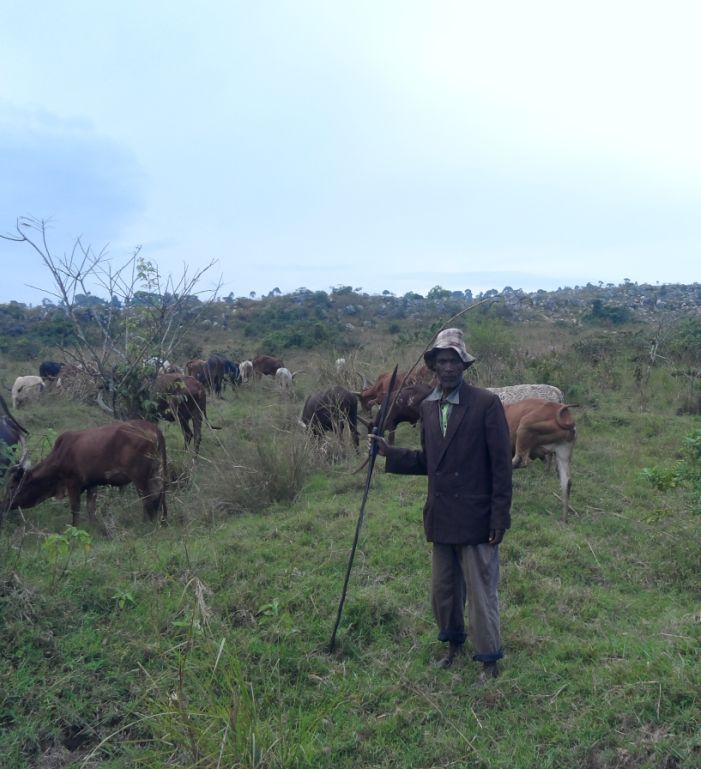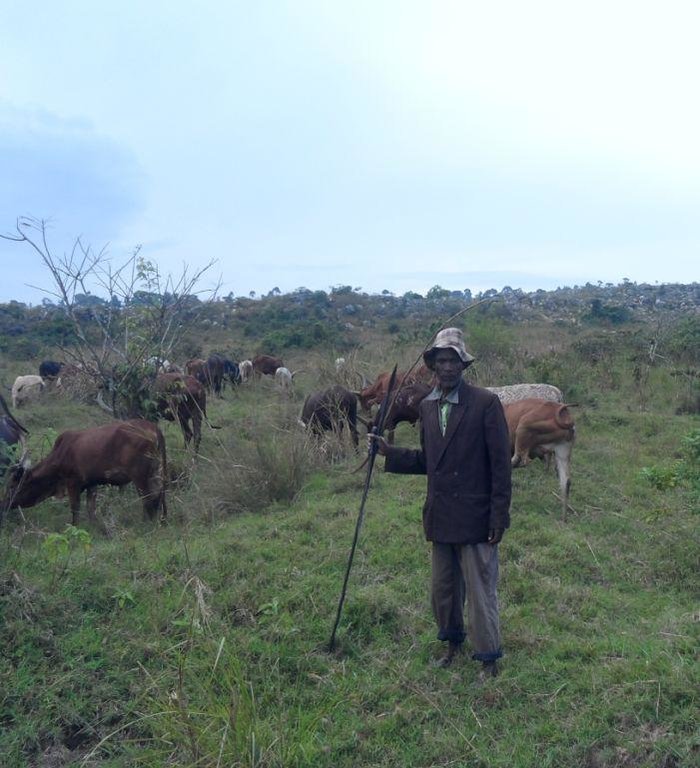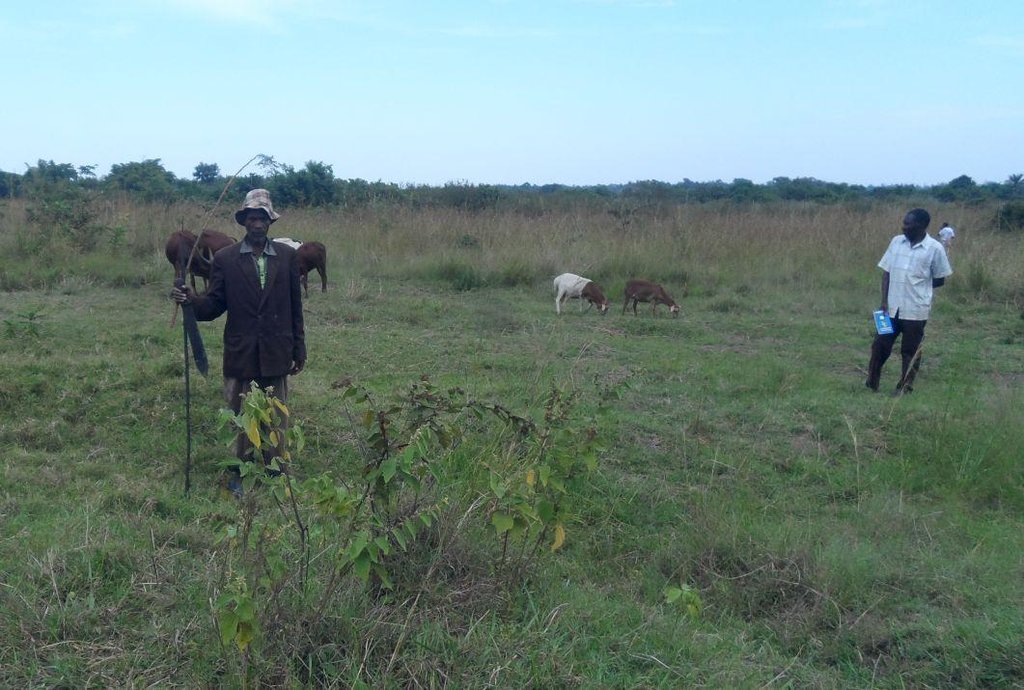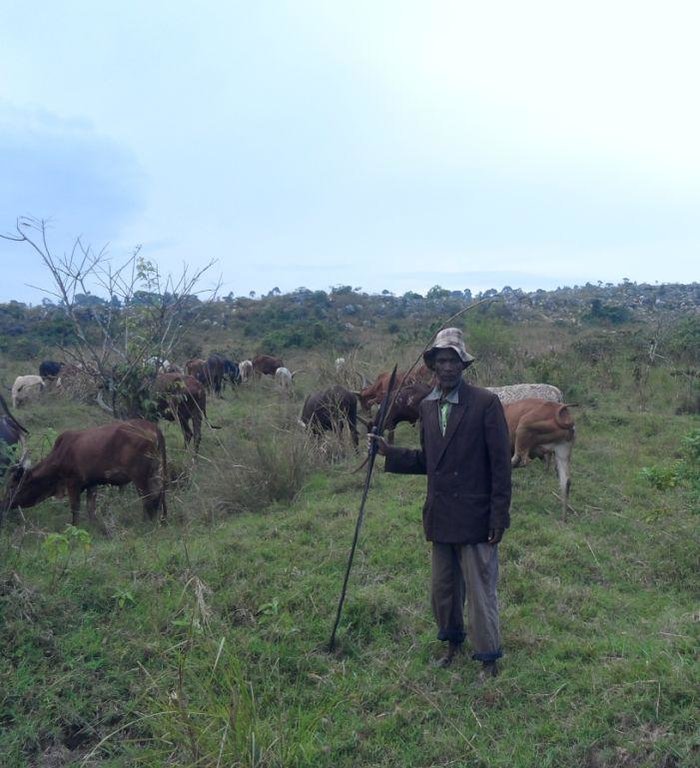Active participation of herder leader (WAKONDO) in management of grassland and riverine ecosystems [República Unida da Tanzânia]
- Criação:
- Atualização:
- Compilador/a: ALLAN BUBELWA
- Editor: –
- Revisor: Fabian Ottiger
Matumizi ya wamiliki wa mifugo (WAKONDO) katika hifadhi na matumizi bora ya nyanda za malisho na bionwai za mto.
approaches_2488 - República Unida da Tanzânia
Veja as seções
Expandir tudo Recolher tudo1. Informação geral
1.2 Detalhes do contato das pessoas capacitadas e instituições envolvidas na avaliação e documentação da abordagem
Especialista em GST:
Especialista em GST:
Egidius Pancras
Missenyi District Council
República Unida da Tanzânia
Nome da(s) instituição(ões) que facilitou(ram) a documentação/avaliação da Abordagem (se relevante)
Bukoba district council (Bukoba district council) - República Unida da TanzâniaNome da(s) instituição(ões) que facilitou(ram) a documentação/avaliação da Abordagem (se relevante)
Missenyi District Council (Missenyi District Council) - República Unida da Tanzânia1.3 Condições em relação ao uso da informação documentada através de WOCAT
Quando os dados foram compilados (no campo)?
03/06/2014
O/a compilador/a e a(s) pessoa(s) capacitada(s) aceitam as condições relativas ao uso de dados documentados através da WOCAT:
Sim
1.4 Referência ao(s) questionário(s) sobre tecnologias da GST
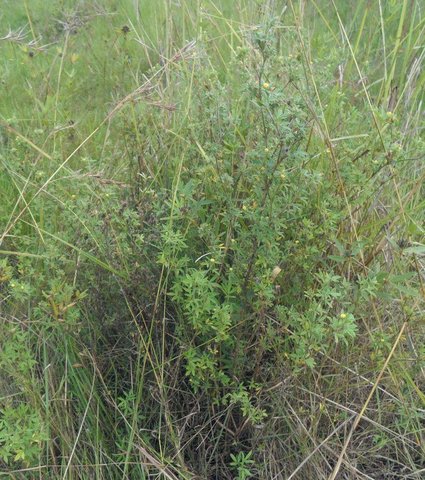
Area enclosures for protection of riverine ecosystem and … [República Unida da Tanzânia]
Area enclosures for protection of riverine ecosystem and purposeful regeneration of mulching and pasture materials for cut and carry
- Compilador/a: ALLAN BUBELWA
2. Descrição da abordagem de GST
2.1 Descrição curta da abordagem
Prevention and mitigation of the grazing land and riverine ecosystems through mandatory grassroots meetings, law enforcement and active participation and empowerment of herder leaders’ (masters of the most resource destructive group)
2.2 Descrição detalhada da abordagem
Descrição detalhada da abordagem:
Aims / objectives: Aim/objectives: Empowering the village community, to take charge prevention and rehabilitation of the degraded and endangered grazing land and riverine ecosystem. Enhance SLM sustainability through agenda mainstreaming operationalization and formalization into existing information sharing and decision making forums. SLM be implemented through complementary and concerted efforts of the central government, local governments, grass roots institutions and the community at large. Community exposure to legal and policy framework guiding SLM and actively engaged in making informed decision.
Methods: Methods: The most resource destructive group is actively engaged and empowered to take the leading role in prevention and mitigation of the endangered and degrading riverine and grazing land ecosystems. SLM matters are formalized /operationalized and becomes permanent agenda in mandatory grassroots information sharing and decision making forums (sub village meetings, village assembly, ward development committee). The use of multi-sectorial concerted efforts that involves direct support by the central government in matters relating to SLM peace and tranquility (e.g. communities provided with mobile phone numbers for timely reporting of any destructive fire incidence and other environmental and peace threatening malpractices). Knowledge management and training (farmer capacity building) scaled up through adult learning methods (e.g. SLM demos). Active involvement of the most resource destructive group (herdsmen and their masters) in planning, implementation, monitoring and evaluation, decision making and bylaw formation and reinforcement. Herders who usually suffer rights to information (due to their tight daily activity clock) are informed, lead and guided by their masters.
Stages of implementation: Implementation starts with land degradation analysis and identification of the red spots (land degradation problems) to be addressed. Development of community SLM site specific action plan indicating the degradation type, proposed prevention and mitigation intervention methods, conservation methodology/approach to use, inputs needed, people /stakeholder involvement and time frame, stakeholder awareness raising plan, training, education and capacity building. Roles distribution, joint implementation, monitoring and evaluation of community action plan.
Role of stakeholders: Community: take charge of SLM activities (e.g. land demarcation, planting of tree, reseeding of pasture, e.t.c.), potential informer of malpractices and play a role of grass roots community guard, detectors of SLM crimes are also responsible for up keeping of public order.
Sub and village governments: formation of village environmental committees, taking leading role in inclusion of SLM agendas in mandatory sub village and village meetings, community mobilization and law enforcement.
WAKONDO: forms the core stakeholders in this approach (as experience shows that herders are the major source of uncontrolled fire burning and intruders of riverine ecosystems), participate in decision making and bylaw formation, guide and frequently remind and lead herders how and where to graze, interpreted bylaws to herders so that they make wise and informed decision and liaise herders with sub village and village government.
Environmental committee: law enforcers, environmental patrollers, direct involvement in SLM activities, awareness creation through various means e.g. use of posters.
District council: Awareness creetion, training, education and capacity building and interpreting to the community laws and policy guiding SLM.
Central government: SLM peace and tranquility and law enforcement.
Other important information: The basic principle underlying this approach is facing SLM through multi-sectorial collaboration and active participation of the most resource destructive group of the community. The average annual costs needed in running the approach is > 2000 USD.
2.3 Fotos da abordagem
2.5 País/região/locais onde a abordagem foi aplicada
País:
República Unida da Tanzânia
Região/Estado/Província:
Tanzania/Kagera
Especificação adicional de localização:
Missenyi/Kitobo/Kyazi
2.6 Datas de início e término da abordagem
Indique o ano de início:
2012
Ano de término (caso a abordagem não seja mais aplicada):
2014
2.7 Tipo de abordagem
- Local initiatives mixed in a comprementary maner with project project initiatives.
2.8 Principais metas/objetivos da abordagem
The Approach focused mainly on SLM with other activities
Empowering and involvement of the community by building confidence, ownership and capacity to take charge prevention and mitigation of the degraded and endangered grazing land and riverine ecosystem. Establishment of active and reliable environmental committee. Make SLM to be permanent agenda and formalized into existing information sharing and decision making forums.
SLM be implemented through complementary and concerted efforts of the central government, local governments, grass roots institutions and the community at large.
The SLM Approach addressed the following problems: Overgrazing and uncontrolled fire burning by herders, who undertake animal caring for WAKONDO (livestock owners), their activity clock is usually occupied and is under the control of their masters, they are voice less, no access to information about SLM, weak and have no power in decision making.
WAKONDO not adequately and effectively engaged in planning and implementing SML activities.
Dormant and inactive environmental committee coupled with lack of SLM technical knowledge.
No clearly defined grassroots forums for developing and dealing permanently with SLM agendas.
Weak, conflicting and disjointed efforts invested to environmental conservation.
2.9 Condição que propiciam ou inibem a implementação de tecnologia/tecnologias aplicada(s) segundo a abordagem
Normas e valores sociais/culturais/religiosos
- Inibitivo
Poor grazing techniques characterized by overgrazing and uncontrolled fire burning.
Treatment through the SLM Approach: Active training and engagement of WAKONDO (cattle owners) in planning, implementation, monitoring, evaluation and SLM decision making.
Disponibilidade/acesso a recursos e serviços financeiros
- Inibitivo
Low quick financial realization by members of the village community who invest their valuable time in SLM (e.g. members of environmental committee)
Treatment through the SLM Approach: Introduce environmental based quick win project (QWP) and income generating activities (IGA).
Quadro institucional
- Inibitivo
Weak and ineffective commitment of the local governments at the grassroots level (sub village, village and ward).
Treatment through the SLM Approach: SLM be formalized as one of the permanent agenda in grassroots planning and decision making forums (mandatory village and sub village meetings).
Quadro jurídico (posse de terra, direitos de uso da terra e da água)
- Propício
The existing land ownership, land use rights / water rights moderately helped the approach implementation: The current bylaws contribute significantly in adherence to environmental conservation and approach objectives.
- Inibitivo
Unlimited and uncoordinated use of grazing and riverine resources. Inadequate law enforcement. Low engagement of the central government (law enforcers and observers of peace and tranquility).
Treatment through the SLM Approach: Demarcation and encrosure of engendered grazing land and riverine ecosystems coupled with use of sign/warning posters. Active engagement of the central government (law enforcers and observers of peace and tranquility) e.g. community awareness and access to DCs phone for reporting crimes and any environmental threatening malpractices.
Conhecimento sobre GST, acesso a suporte técnico
- Inibitivo
Unintended results in management of the grazing land ecosystem (e.g. emergency of invasive species)
Treatment through the SLM Approach: Research and find alternative use of the invasive species and mobilize for controlled and organized consumption.
Carga de trabalho, disponibilidade de força de trabalho
- Inibitivo
High work load to members of village environmental committee.
Treatment through the SLM Approach: Development of regular time table and are the priority and potential beneficiaries of IGA.
3. Participação e papel das partes interessadas envolvidas
3.1 Partes interessadas envolvidas na abordagem e seus papéis
- Usuários de terra/comunidades locais
Community at large, Environmental groups/commitees, WAKONDO and herders. Individual local communities (youth, elders, male and females)
Farmer groups, environmental committees (males and females). Almost gender balanced environmental committee, active participation of the youth and indiscriminate participation of disabled (as a matter of fact the chairperson of environmental committee is an handicapped)
- Especialistas em GST/ consultor agrícola
Site facilitators (all males), District SLM multidicipline team (femals and males) . District Planning Team
- Governo local
District, Village and Sub village governmen, village leaders and ward community representatives (Councilors).
- Governo nacional (planejadores, responsáveis pelas decisões)
Central Government
- Organização internacional
Transboundary Agroecosystem Project (TAMP)
3.2 Envolvimento do usuários de terra/comunidades locais nas diferentes fases da abordagem
| Envolvimento do usuários de terra/comunidades locais | Especifique quem estava envolvido e descreva as atividades | |
|---|---|---|
| Iniciação/motivação | Participativo | Village council members and field experts - sensitization and awareness creation meetings. |
| Planejamento | Participativo | Village government, community and site facilitators - SLM planning meetings. |
| Implementação | Participativo | Village government, community, groups and committees and site facilitators - Actual implementation of community site specific action plan. |
| Monitoramento/avaliação | Participativo | Village government, community, groups and committees and site facilitators - Actual monitoring and evaluation of community site specific action plan. |
| Research | Participativo | Village government, community, groups and committees and site facilitators - client focused research to deal with undesirable and unintended results (e.g. on how to handle invasive species). |
3.4 Decisão sobre a seleção de tecnologia/tecnologias de GST
Especifique quem decidiu sobre a seleção de tecnologia/tecnologias a serem implementadas:
- Principalmente usuários da terra, apoiados por especialistas em GST
Explique:
Decision over the technology was a resultant of site characterization technically backstopped by SLM specialists and actively participated by the empowered and informed community.
Decisions on the method of implementing the SLM Technology were made by mainly by land users supported by SLM specialists. The method was the resultant of a process phases and steps dialogue, discussion and consensus attained between land user and SLM specialists.
4. Suporte técnico, reforço das capacidades e gestão do conhecimento
4.1 Reforço das capacidades/ formação
Foi oferecida formação aos usuários da terra/outras partes interessadas?
Sim
Especifique quem foi capacitado:
- Usuários de terra
- Equipe de campo/consultores
- leaders and politicians
Caso seja relevante, especifique gênero, idade, status, etnia, etc.
all gender (male and female), all age (youth and elders), all status (the rich WAKONDO and the poor herders) and all ethnic group
Tipo de formação:
- Em exercício
- Áreas de demonstração
- Reuniões públicas
Tipo de formação:
- special and adhoc serminars
Assuntos abordados:
Fire control, grazing management, forest management, pasture establishment and use of bylaws.
4.2 Serviço de consultoria
Os usuários de terra têm acesso a um serviço de consultoria?
Sim
Especifique se foi oferecido serviço de consultoria:
- nas áreas dos usuários da terra
Descreva/comentários:
Name of method used for advisory service: Group method ; Key elements: Site vist and stakeholders visit, Group discussion, interaction and concensus building, local knowledge and technical knowledge balanced in a comprementary manner; Land users were visited by the experts and discussions held either on the site or elsewhere.
Advisory service is inadequate to ensure the continuation of land conservation activities; There is shortage of staff and the few staff have high workload/are given multiple tasks.
4.3 Fortalecimento da instituição (desenvolvimento organizacional)
As instituições foram fortalecidas ou estabelecidas através da abordagem?
- Sim, pouco
Especifique a que nível (níveis) as instituições foram fortalecidas ou estabelecidas:
- Local
Especifique o tipo de apoio:
- Reforço das capacidades/ formação
Dê mais detalhes:
Members of environmental committee were provided with various SLM trainings.
4.4 Monitoramento e avaliação
Monitoramento e avaliação são partes da abordagem?
Sim
Comentários:
bio-physical aspects were regular monitored by land users through observations; indicators: number of pasture growing species
technical aspects were regular monitored by project staff, land users through measurements; indicators: percentage increase in vergetation cover
socio-cultural aspects were ad hoc monitored by land users through observations; indicators: incedences of fire burning
economic / production aspects were regular monitored by land users through measurements; indicators: number of grass bundles harvested
area treated aspects were regular monitored by land users through measurements; indicators: % hacterage protected and harvested
no. of land users involved aspects were regular monitored by land users through measurements; indicators: number of adopters/participants
management of Approach aspects were regular monitored by land users through observations; indicators: Number of FFS, Demos and IGA, patrols meetings
There were several changes in the Approach as a result of monitoring and evaluation: arrangement for the community to find alternative uses of unintended products in pasture establishment (alternative use of invasive species) .
There were several changes in the Technology as a result of monitoring and evaluation: Monitoring and evaluation revealed the need to integrate SLM quick win project/IGA as stimulus factor to members of environmental committee who spend their valuable time in performing SLM activities.
5. Financiamento e apoio material externo
5.1 Orçamento anual para o componente de GST da abordagem
Caso o orçamento exato seja desconhecido, indique a faixa:
- < 2.000
Comentários (p. ex. principais fontes de recursos/principais doadores):
Approach costs were met by the following donors: international (Transboundary Agroecosystem project): 25.0%; government (Central Government ): 5.0%; local government (district, county, municipality, village etc) (Village government and District council ): 18.0%; local community / land user(s) (Community, groups, village invironmental commitees ): 52.0%
5.2 Apoio financeiro/material concedido aos usuários da terra
Os usuários da terra receberam apoio financeiro/material para a implementação de tecnologia/tecnologias?
Sim
5.3 Subsídios para entradas específicas (incluindo mão-de-obra)
- Agrícola
| Especifique quais entradas foram subsidiadas | Em que medida | Especifique os subsídios |
|---|---|---|
| Sementes | Totalmente financiado | Pasture seed |
| Fertilizantes | Parcialmente financiado | DAP |
Se a mão-de-obra pelos usuários da terra foi uma entrada substancial, isso foi:
- Recompensado com outras formas de apoio material
Comentários:
the were rewarded indirectly through IGA and input provision
pasture seeds were supported fully but fertilizer was inadequate due to lean budget.
5.4 Crédito
Foi concedido crédito segundo a abordagem para atividades de GST?
Não
6. Análise de impactos e declarações finais
6.1 Impactos da abordagem
A abordagem auxiliou os usuários da terra a implementar e manter as tecnologias de GST?
- Não
- Sim, pouco
- Sim, moderadamente
- Sim, significativamente
Improvement of vegetation cover through controlled fire burning, livelihood diversification through sell of mulching and pasture materials, protection of the grazing land and riverine ecosystem ensured through area enclosure, demarcation and controlled harvesting of mulching and pasture materials.
A abordagem concedeu autonomia aos grupos social e economicamente desfavorecidos?
- Não
- Sim, pouco
- Sim, moderadamente
- Sim, significativamente
Youth, women and the disabled interms of livelihood and income
Did other land users / projects adopt the Approach?
- Não
- Sim, pouco
- Sim, moderadamente
- Sim, significativamente
Did the Approach lead to improved livelihoods / human well-being?
- Não
- Sim, pouco
- Sim, moderadamente
- Sim, significativamente
additional income accrued through mulching and pasture materials to casual labour, transporters and farmers.
Did the Approach help to alleviate poverty?
- Não
- Sim, pouco
- Sim, moderadamente
- Sim, significativamente
Alternative income sources and improved money circulation.
6.2 Principal motivação dos usuários da terra para implementar a GST
- Produção aumentada
expectation of getting high palatable pastures and mulching material for use and sale
- Lucro (lucrabilidade) aumentado, melhora da relação custo-benefício
Profit realized from improved animal and crop production arizing from use of pasture and mulch
- normas e regulamentos (multas)/aplicação
People worry purnishment in terms of pernaties and standing before the court of law.
- Afiliação a movimento/projeto/grupo/rede
Benefit from SLM projects in terms of IGA and easy access to extension services.
- Consciência ambiental
Change of mindset through awareness creation and sensitization meetings/seminars.
- well-being and livelihoods improvement
dirvesification of income sources (income from the sell of mulching and pasture materials)
6.3 Atividades de sustentabilidade de abordagem
Os usuários da terra podem manter o que foi implementado através da abordagem (sem apoio externo)?
- Sim
Caso afirmativo, descreva como:
Because the approach is internationalized and formalized into the existing systems (e.g. SLM becomes permanent agenda in mandatory sub village and village meetings).
The use of goat loan IGA project where farmers are given goats on loan bases and pay goats which are then passed and spread to more of their fellow farmer can continue without support.
Involvement of central government e.g. access of district commissioners and divisional officers phone is a reliable SLM crime control mechanisms which does not require any of external support (a mere text message can save and protect abundant hectare of land).
6.4 Pontos fortes/vantagens da abordagem
| Pontos fortes/vantagens/oportunidades na visão do usuário da terra |
|---|
| Improvement of the natural vegetation (How to sustain/ enhance this strength: To continue community education ) |
| Availability of mulching materials (How to sustain/ enhance this strength: Controlled harvesting and fire prevention ) |
| Availability of fuel wood (How to sustain/ enhance this strength: Permanent and routine guard ) |
| Pontos fortes/vantagens/oportunidades na visão do/a compilador/a ou de outra pessoa capacitada |
|---|
| Incorporation internalization of SLM as permanent agenda in reliable mandatory grassroots forums (sub village and village meetings) (How to sustain/ enhance this strength: Continue internalization and SLM promotion through use of existing forums.) |
| Involvement of the central government (a mere text message can save and rescue abundance of hectare). (How to sustain/ enhance this strength: Continue use of the central government.) |
| Empowerment and active participation of the the most resource destructive and environmental threatening group (livestock keepers). (How to sustain/ enhance this strength: Continue use of WAKONDO (livestock owners) in planning, implementation and deciding SLM activities. ) |
| Use of self spreading IGA to motivate environmental committee members who spend their valuable time in SLM activities (e.g. goat loan projects). (How to sustain/ enhance this strength: Continue promotion, expansion and sustaining of self spreading IGAs.) |
| Dialogue and communication takes into consideration the daily activity clock of the stakeholder (through this principle WAKONDO can deliver SLM messages to herdsmen rather than SLM specialist) (How to sustain/ enhance this strength: Daily activity clock continue to be a criteria for planning SLM dialogue and communication.) |
6.5 Pontos fracos, desvantagens da tecnologia e formas de superá-los
| Pontos fracos/desvantagens/riscos na visão do usuário da terra | Como eles podem ser superados? |
|---|---|
| shortage of working gears (umbrella, gumboots, raincoats and stationary) | Ensure availability of working gears (e.g. SLM penalties be used to cover the costs of working gears). |
| Inadequate fund to support IGA | Commit adequate fund to support and expand IGA. |
| Violation of rules and procedures by some untrustworthy individuals | Strengthen law enforcement (use of penalties, court and ward tribunals) |
| No reliable transport for village environmental committees. | Ensure reliable transport for the village environmental committee. |
| Pontos fracos/vantagens/riscos na visão do/a compilador/a ou de outra pessoa capacitada | Como eles podem ser superados? |
|---|---|
| Existence of untrained-able and lazy herdsmen and less committed WAKONDO. | Strengthen law enforcement (e.g. use of penalties) |
| No reliable forum to collaborate with supplier of inputs and research as a results failure to figure out the reasons for unintended results (for this case unpalatable alien/native species overshadowed the palatable pasture and the reasons were not known) | Strengthen collaborations with Research and supplier of inputs (pasture seeds e.t.c.). |
7. Referências e links
7.1 Métodos/fontes de informação
- visitas de campo, pesquisas de campo
- entrevistas com usuários de terras
7.2 Referências às publicações disponíveis
Título, autor, ano, ISBN:
A report on Kyazi Microcatchment Characteriaztion
Links e módulos
Expandir tudo Recolher tudoLinks

Area enclosures for protection of riverine ecosystem and … [República Unida da Tanzânia]
Area enclosures for protection of riverine ecosystem and purposeful regeneration of mulching and pasture materials for cut and carry
- Compilador/a: ALLAN BUBELWA
Módulos
Não há módulos


